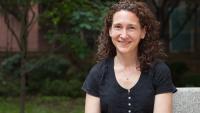Julie Herbstman

Assistant Professor of Environmental Health Sciences
Trained as an epidemiologist, Julie Herbstman’s research focuses on the impact of prenatal exposures to environmental toxins, including flame retardants and air pollutants, on child growth and development. She has been involved in research exploring the long-term effects of exposure to pollutants from the collapse of the World Trade Center and, most recently she and colleagues at the Columbia Center for Children’s Environmental Health have used epigenetic biomarkers to trace the mechanistic pathways between prenatal exposures and disease risk.
What kind of science do you conduct at the Columbia Center for Children’s Environmental Health?
Our Center has a strong focus on molecular epidemiology, so we try to understand the mechanistic pathways, not just “exposure A leads to outcome B.” My colleagues and I are always looking to understand the molecular steps by which environmental impacts happen. In my work, I look at prenatal and early childhood exposure to a variety of environmental pollutants and their impact on child health and neurodevelopment.
So that’s molecular biology, right? A quote-unquote “hard” science?
Well, no. The reason to do public health research is because you’re motivated by the way the work will be translated. I’m not trained as a policy person, of course, but my research into flame retardant exposure, for example, has informed a lot of public policy. And believe me, flame retardants are in everything under the sun. My research has shown that that prenatal exposure leads to IQ loss. So while there are industrial interests from manufacturers on one side, there has also been pressure to revise the standard in the state of California, which is one of the largest market for furniture in the U.S., and now, no longer require that couches and baby mattresses contain these harmful chemicals.
Is there a difference between a conversation about chemical pollutants in a public health school and in a department of chemistry?
For us, the bottom line for everything we do is “so what?” The work we do needs to have a “so what?” What does this mean for public health? What does this mean for the population you’re studying? Basic science programs may say the same thing, but their work rarely has the same far-reaching public health application. If I’m doing research and I cannot figure out who might benefit from it, I need to be spending my time doing something else.
Do you think entering students to the Mailman School understand that?
I definitely do. And remember, whether they’re coming straight from undergraduate public health programs or they’ve been in the workplace for a few years, they’re highly motivated when they arrive. Our students have been energized by issues related to climate change and environmental sustainability, particularly in my department, with a wonderful feeling that they can really do something. If you get beat down after a long academic year, you get a tremendous burst of energy from new students every September because they’re so excited and so motivated and have so many ideas. They know they’re the ones who can make a difference.
See more EHS Faculty Spotlights.